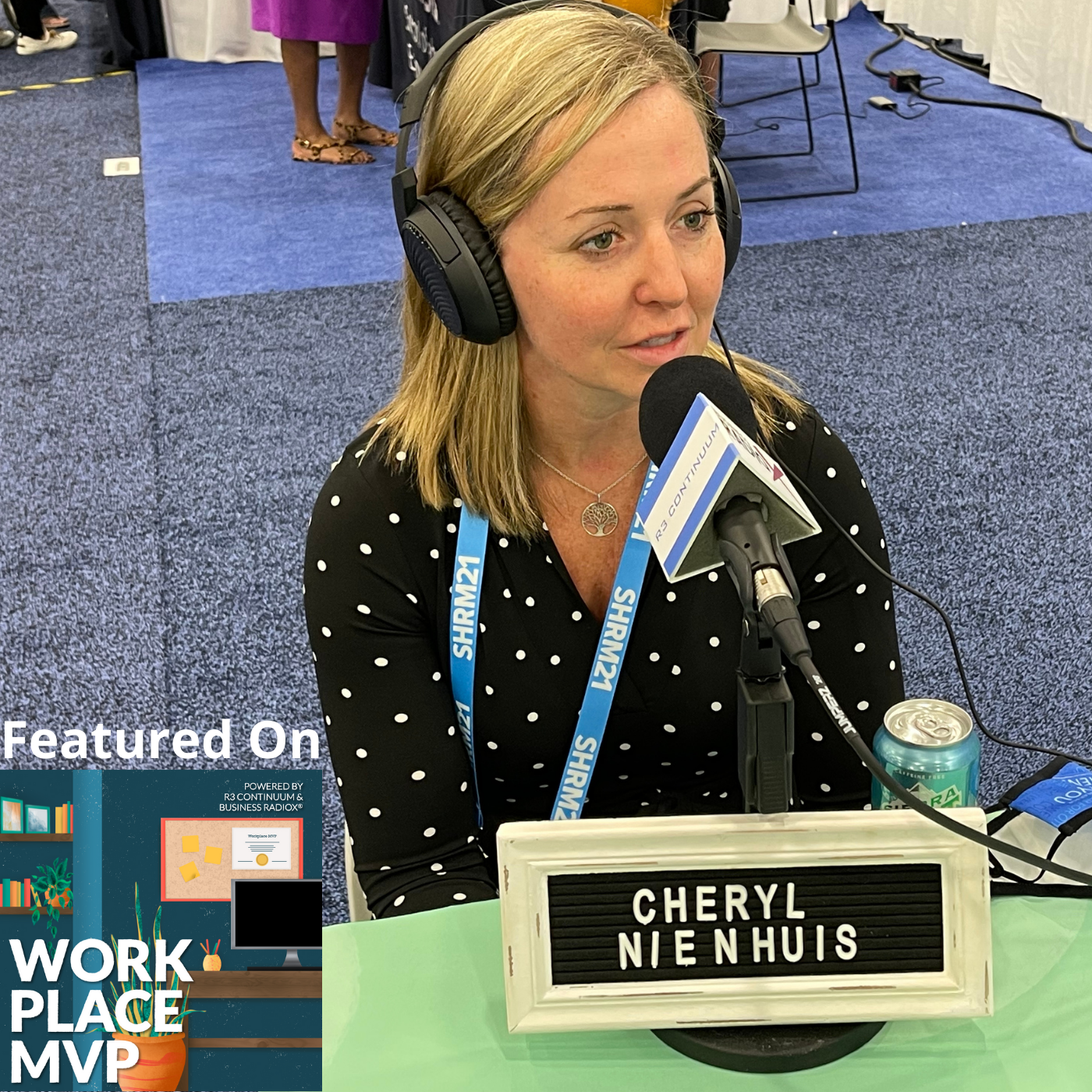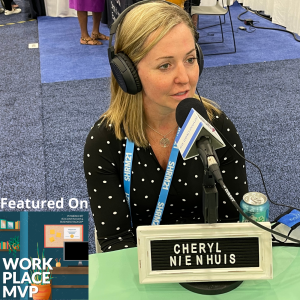
Workplace MVP LIVE from SHRM 2021: Cheryl Nienhuis, Mayo Clinic
As Director of the Complex Care Program at the Mayo Clinic, Cheryl Nienhuis helps employers and their employees with access to specialized care for complex medical cases. She joined host Jamie Gassmann on this live edition of Workplace MVP to discuss her career journey and her work at the Mayo Clinic. Workplace MVP is underwritten and presented by R3 Continuum and produced by the Minneapolis-St.Paul Studio of Business RadioX®.
This show was originally broadcast live from the 2021 SHRM Annual Conference held at the Las Vegas Convention Center in Las Vegas, Nevada.
Cheryl Nienhuis, Director – Complex Care Program, Mayo Clinic

Cheryl Nienhuis is the Director of the Complex Care Program at Mayo Clinic. She builds relationships with employers, payers, and third-party administrators to ensure that complex patients have access to Mayo Clinic’s destination medical centers in Arizona, Florida, and Rochester.
Cheryl has been with Mayo Clinic for about fifteen years starting in the Human Resources Department, and most recently joined the Complex Care Program Team. She works with employers helping them with benefits design of complex conditions and identification and referral to help manage costs.
Complex Care Program, Mayo Clinic
When employees or members of an employer’s medical plan are experiencing fragmented care, ineffective treatments, potential misdiagnoses, or difficulty accessing specialized care for complex conditions, Mayo Clinic can help.
At their campuses in Arizona, Florida and Minnesota, teams of the world’s leading experts from every medical specialty and subspecialty work together to ensure the best possible outcome for each patient.
The Mayo Clinic Complex Care Program offers managed access (expedited scheduling and condensed appointment itineraries) to Mayo Clinic’s high-quality, cost-effective care for individuals with complex, rare, or undiagnosed medical conditions. In other words, Mayo Clinic helps minimize costs while getting patients exactly the care they need.
About Workplace MVP
Every day, around the world, organizations of all sizes face disruptive events and situations. Within those workplaces are everyday heroes in human resources, risk management, security, business continuity, and the C-suite. They don’t call themselves heroes though. On the contrary, they simply show up every day, laboring for the well-being of employees in their care, readying the workplace for and planning responses to disruption. This show, Workplace MVP, confers on these heroes the designation they deserve, Workplace MVP (Most Valuable Professionals), and gives them the forum to tell their story. As you hear their experiences, you will learn first-hand, real-life approaches to readying the workplace, responses to crisis situations, and overcoming challenges of disruption. Visit our show archive here.
Workplace MVP Host Jamie Gassmann

In addition to serving as the host to the Workplace MVP podcast, Jamie Gassmann is the Director of Marketing at R3 Continuum (R3c). Collectively, she has more than fourteen years of marketing experience. Across her tenure, she has experience working in and with various industries including banking, real estate, retail, crisis management, insurance, business continuity, and more. She holds a Bachelor of Science Degree in Mass Communications with special interest in Advertising and Public Relations and a Master of Business Administration from Paseka School of Business, Minnesota State University.
R3 Continuum
R3 Continuum is a global leader in workplace behavioral health and security solutions. R3c helps ensure the psychological and physical safety of organizations and their people in today’s ever-changing and often unpredictable world. Through their continuum of tailored solutions, including evaluations, crisis response, executive optimization, protective services, and more, they help organizations maintain and cultivate a workplace of wellbeing so that their people can thrive. Learn more about R3c at www.r3c.com.
Company website | LinkedIn | Facebook | Twitter
TRANSCRIPT
Intro: [00:00:04] Broadcasting live from the SHRM 2021 Conference at the Las Vegas Convention Center, it’s time for Workplace MVP. Brought to you by R3 Continuum, a global leader in workplace behavioral health, crisis, and security solutions. Now, here’s your host.
Jamie Gassman: [00:00:23] Hello, everyone. Jamie Gassman here, your host of Workplace MVP, and we’re recording our episodes today from the Day 2 of SHRM 2021 here in Las Vegas, Nevada. And with me is Cheryl Nienhuis, who is the director of Complex Care from Mayo Clinic. Welcome to the show.
Cheryl Nienhuis: [00:00:44] Hi, Jamie. Thank you for having me.
Jamie Gassman: [00:00:46] So, share with us kind of your career background and what you do at Mayo Clinic.
Cheryl Nienhuis: [00:00:52] Great. I feel like I started my career in health care when I was about six years old. I won’t take you through all of the steps. But I remember pre-HIPAA, I’m sitting there and folding statements with my mom, from the doctor’s office that she worked for, and my career’s just kind of gone into the HR direction since then. And, I’ve spent the last 15 years almost at Mayo Clinic, most of that in our benefits department, making sure that we’re taking care of our employees so they can take care of our patients.
Cheryl Nienhuis: [00:01:22] And so, recently, I’ve joined the Complex Care Program team to really help employers make a positive difference in the lives of their employees by steering them to the right care for those individuals dealing with complex conditions and really working with them on a benefits design and identification and referral to help them manage their healthcare costs as well, as health care is continuing to be a very high cost for employers, which again they are having to share with their employee population. So, how can we help them get the right diagnosis early on and get the right treatment plan so they can get back to work and have the best outcomes possible?
Jamie Gassman: [00:01:57] And so, what are some of the, you know, kind of examples of how maybe a case scenario or something to that effect of, like, how an employer has used your program?
Cheryl Nienhuis: [00:02:05] Yeah. That’s a great question. So, a lot of employers deal with a lot of complex conditions with high spending cancer care or spine care. There’s a lot of overutilization with spine surgeries in the United States. And so, we really work with the employers to identify these individuals through their case management or their TPA or navigation service to steer care to Mayo Clinic for medical record review to see if they would benefit by coming to Mayo. And, if they would benefit by coming to Mayo, we ask the employers to pay for the travel and lodging. And, a lot of times these individuals are getting a change in their diagnosis and the right treatment path.
Cheryl Nienhuis: [00:02:47] So, in the instance of spine care, a lot of times they’re not needing spine surgery that was recommended locally, and a more conservative treatment is available for that individual. And so, it’s better outcomes for that individual to get the right treatment that they need and it’s better outcomes as well for the medical plan because they’re not having to pay for unnecessary procedures.
Jamie Gassman: [00:03:08] Absolutely. So, from an outcome perspective, would we be looking at, you know, maybe increasing the return to work duration so that it’s shorter in cycle than what would maybe have happened on a different – you know if they’ve gone through like the original diagnosis and treatments?
Jamie Gassman: [00:03:22] Absolutely. So, getting to work faster, you know also controlling the cost on short- and long-term disability, more presenteeism, because that individual is getting the right care. There are times when we see somebody come in for a spine surgery and they don’t have a spine issue. You know, it’s a hip condition or a shoulder, or sometimes even a heart condition, where if they went on with that surgery, they wouldn’t have gotten better and things would have still been costly for the employer.
Jamie Gassman: [00:03:52] Yeah. It would have almost, like, gotten worse potentially because they get done with that spine surgery and still having some issues.
Cheryl Nienhuis: [00:03:58] Absolutely.
Jamie Gassman: [00:03:58] Now, you had mentioned before we got, and when we started recording the episode, something about conflict resolution. Can you kind of dive into that a little bit about some of the work that you guys are doing in that aspect?
Cheryl Nienhuis: [00:04:10] Right. So, I think with the benefit design, all right, it’s a little hard to get employees to understand what their benefits are. I just read a recent study that said about 80% of employees don’t read their benefits, and out of that, 45% don’t understand what they’re reading. And so, they really go to their coworkers and everyone to understand their benefits. And so, really, there’s a misfit there in what we’re trying to do from an HR perspective in getting employees to understand their information.
Cheryl Nienhuis: [00:04:42] And so, we really work on proactively communicating the benefits and really streamlining the process for individuals so they’re not lost in the health care when they need it most, right. And so, really, removing the barriers and the confusion I think proactively has really helped a lot of people have more of a positive member patient experience. So, we’re trying to remove the conflict in the fragmented care or just health care in general to really remove the barriers there for a positive experience.
Jamie Gassman: [00:05:18] And I bet that’s like, you know, that’s probably some of the more common. Like, they don’t read it. And, you know, the terminology sometimes used in those materials is, like, I don’t know what that means, you know. So, I love that proactive approach [inaudible]. So, do you change the way that that’s communicated then? Do you modify, kind of, some of the approaches to how you’re informing those employees? And what does that look like if you do that?
Cheryl Nienhuis: [00:05:42] Yes, absolutely. So, we really work with the employers. We actually have a dedicated marketing communications manager that works with everyone that we work with to really identify how are they currently communicating and where all of their employees are located.
Cheryl Nienhuis: [00:05:58] You know, an example is working with a group that has truck drivers, right. How are the truck drivers going to be getting their information because they’re on the road? They don’t have the technology that they need. And if they do, they’re not using it to read benefits communications, right. And so, really working with an employer to create radio ads for their truck drivers, you know, because they’re going to be listening to the radio and they’re going to be hearing those types of things on the radio while they’re driving. So, really working with coming up with great ideas that may be out of the norm.
Cheryl Nienhuis: [00:06:29] We also encourage them to look at what their employees are saying. So many times we hear about, okay, do this, do that, from a communication perspective. But we’ve done surveys of where employees are actually listening and getting their information with employers to make sure that we’re addressing where they’re actually looking. And, a lot of times we find that they’re wanting or looking in places that the information is not available. So, we try and work and steer those employers to create a marketing and communication strategy that will benefit them and their employees.
Jamie Gassman: [00:07:03] Fantastic. Especially in today’s world of stress and burnout, reading another piece of, you know, literature in a long email isn’t going to be as effective as doing something that I can listen to it or I can watch it. So, that’s fantastic and kind of meeting that employee where they’re at is so powerful.
Cheryl Nienhuis: [00:07:20] Absolutely. Keeping that message simple, right. And, again, it’s not just – that message is how do you work and streamline your benefit strategy with the vendors that you work with. So, if a person happens to call the wrong vendor for something, which happens more than we’d like to admit, you know the vendors that are selected understand the programs overall that are being offered by their employer. And so, if they are calling the wrong place, that vendor is educated on where that employee should go. Again, so they’re giving the answer that they need, and then also really creating a strategy for the vendors that are working together to work together to create that positive patient experience.
Cheryl Nienhuis: [00:08:00] And so, we’ve seen a lot of groups going with wonderful, you know, telehealth. But with telehealth, making sure that they have a vendor that they can work with where if there is a complex condition, that telehealth group knows where to refer that complex condition or somebody that’s needing additional care from primary to specialty care. Again, that positive patient experience and member experience is the most important and the best outcome for the employer and the patient member.
Jamie Gassman: [00:08:28] Fantastic. Now, you’re an exhibitor here.
Cheryl Nienhuis: [00:08:30] Yes.
Jamie Gassman: [00:08:30] If there’s anyone listening, you know, from the SHRM attendees, which booth are you in and where can they find you?
Cheryl Nienhuis: [00:08:37] We are in Booth 5044 and I’m happy to talk to anybody. We’re also available if you just Google Mayo Clinic Complex Care and you can learn more about our program there.
Jamie Gassman: [00:08:48] And if they wanted to get in touch with you directly, Cheryl, how would they be able to do that?
Cheryl Nienhuis: [00:08:51] They can go ahead and find me on LinkedIn, or they could just give me a call at 507-422-6103. Happy to talk to anybody. Again, our goal is to really help employers and their employees and members and their employee loved ones that are dealing with complex conditions because our goal is to focus on the needs of the patient and to bring hope when there seems to be confusion and hopelessness.
Jamie Gassman: [00:09:15] Wonderful. Well, thank you so much for joining us today. And, again, if you are listening in from the SHRM Conference, stop by Booth 4076 as well and check out our Workplace MVP podcast being broadcasted from R3 Continuum’s booth. Thanks for listening!















